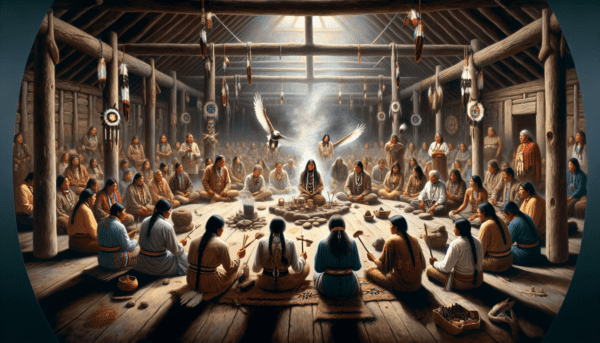- Introduction
- Historical background
- The role of the Yuwipi man
- Preparations and course of the ceremony
- The importance of spirits and their invocation
- Modern relevance and continuation of tradition
- Conclusion
1. introduction
The Yuwipi ritual is a deeply rooted, sacred ceremony that is a central part of the tradition of the Lakota people. It is a traditional healing ritual that is supported by the power of the spirits, supernatural energies and the close community. The term "Yuwipi" translates as "they wrap him" or "they bind him", referring to the unique practice in which the Yuwipi man, a healer in Lakota culture, is bound and blindfolded during the ceremony. This ritual not only provides healing and protection, but also strengthens the spiritual bond within the community and connects participants to the deep traditions of the Lakota and other indigenous peoples.
The relationship with the spirits, the use of healing chants, drums and prayers as well as the physical and spiritual cleansing through sweat lodges are elementary components of the Yuwipi ritual that emphasize its effectiveness and importance. In this article, we will provide a detailed insight into the Yuwipi and Nowampi, from historical background and the role of the Yuwipi man to modern relevance and how these ancient rituals still strengthen community and promote individual vision and healing today.
2. historical background
Origin of the Yuwipi ritual
The Yuwipi ritual, deeply rooted in Oglala Lakota culture, was originally introduced by Woptura, a respected Oglala Lakota. This ritual is an important spiritual practice that continues to this day and is considered an essential part of Lakota spirituality and culture.
Significance and continuity in modern Lakota culture
The significance of the Yuwipi ritual extends far beyond its historical context and remains a vital part of Lakota culture and spirituality. This profound ceremony not only provides healing and spiritual protection, but also fosters a sense of community and connection to traditional Lakota values.
Missing historical details
It is important to mention that specific historical details about the Yuwipi and Nowampi ritual are unfortunately not available. The information that could have helped to fill this gap is not accessible due to a technical error during processing. This underscores the challenges of documenting and preserving indigenous traditions and the need to safeguard these cultural treasures through ongoing research and oral traditions.
3. the role of the Yuwipi man
The Yuwipi man plays a crucial role as a mediator between the physical and spiritual worlds. He is bound during the ceremony and connects the participants with the spirits. The specific tasks and practices of the Yuwipi man are detailed here:
Invitation of the spirits
- Chants and ritualsThe Yuwipi man sings sacred songs and burns sweet grass and sage to invoke the spirits.
- Use of rattlesRattles are used to call the spirits to take part in the ceremony.
Communication with the spirits
- Interpretation of the messagesThe spirits communicate through the Yuwipi man, who interprets their messages for those present.
- Connection setupA strong connection with the spirits is essential to ensure the success of the ceremony.
Preparation and execution of the ceremony
- Creating a sacred spaceThe Yuwipi man sets up the "lodge", a sacred place where the spirits are invited to participate.
- Use of sacred objectsA buffalo skull, eagle feathers and other sacred objects are used to invoke and communicate with the spirits.
Spiritual connection and respect
- Deep respect and trustThe Yuwipi man must establish a deep relationship of trust and respect with the spirits in order to secure their cooperation and support.
- Spiritual toolsVarious items such as the "Spirit Stick", the "Spirit Plate" and the "Spirit Bundle" are used to call the spirits and facilitate communication.
Requirements and lifestyle of the Yuwipi man
- Strict protocolsThe Yuwipi man follows strict protocols, including abstinence from certain foods and the performance of cleansing rituals.
- High requirementsThe ceremony is often very strenuous for the Yuwipi man, as it requires a lot of concentration and is energetically demanding.
Spiritual role and cultural significance
- Waved - two-spirit personThe Yuwipi man has a special role in Lakota culture as the 'Winkte', known for the union of male and female qualities.
- Mediator roleHe is often chosen by the spirits themselves through visions or dreams and acts as an intermediary between the spiritual and the physical world.
These tasks and practices show how central the role of the Yuwipi man is in the performance and success of the Yuwipi ceremony. He is not only a spiritual leader, but also a keeper of the cultural and religious traditions of the Lakota.

4. preparations and course of the ceremony
The preparations for the Yuwipi ceremony are profound and require careful planning and execution to ensure the proper honoring and invocation of the spirits. Here is a detailed description of the steps taken to prepare and perform the ceremony:
Preparation of the room and the altars
- Construction of the altarBefore the ceremony, a special altar is erected. This serves as the central point for the spiritual activities.
- Cooking the ceremonial dishesSpecial dishes are prepared and distributed to the participants during and after the ceremony.
- Cleaning the roomThe room where the ceremony takes place is purified with sage and sweet grass to create a pure and sacred atmosphere.
- Marking the four cardinal pointsFour sticks representing the cardinal points are used to align the space. Tobacco bundles containing prayers are used to define and energize the sacred space.
Performing the sweat lodge ceremony
- Inipi ceremonyYuwipi ceremony: A sweat lodge ceremony takes place before the actual Yuwipi ceremony. This serves to physically and mentally cleanse the participants and marks the transition from the physical to the spiritual world.
Main ceremony
- Positioning of the Yuwipi manThe Yuwipi man is placed on the altar by helpers as he can no longer move himself. His hands are tied behind his back and he is wrapped in a blanket.
- Darkening the roomThe ceremony takes place in complete darkness to enhance the presence and effect of the spirits.
- Chanting and invoking the spiritsThe singers begin with traditional songs that attract the spirits and move them through the room.
- Prayer circleParticipants gather in a circle and prayers are said, beginning with the women and ending with a woman holding the pipe and praying for all present.
Conclusion of the ceremony
- Release of the Yuwipi manAfter the healing round is completed, the spirits release the Yuwipi man's bonds and he is free again.
- Distribution of healing energyThe healing energy transmitted by the spirits is distributed to all participants.
- Songs of thanks and distribution of the foodAt the end of the ceremony, songs of thanks are sung and the blessed food is distributed among the participants.
- Exchange of experienceAn exchange circle gives participants the opportunity to share their experiences and ask questions.
These structured and carefully executed steps ensure that the Yuwipi ceremony is not only a spiritual experience, but also a deep connection with traditional Lakota practices.
5 The meaning of the spirits and their invocation
The spirits play a central role in the Yuwipi ritual, acting as a link between the physical world and the spiritual plane. Their invocation is an essential part of the ceremony, as they offer healing, protection and wisdom.
Communication and the influence of spirits
The spirits are invoked as part of the Yuwipi ritual to seek guidance, healing and protection. This is done through various ritual practices using the Yuwipi man as a medium to communicate with these supernatural beings. The spirits, both good and bad, are invited to help with personal or community problems such as illness, family disputes or natural disasters.
Specific spirits in the ceremony
- Animal spiritsSpecial importance is attached to the spirits of certain animals, such as the buffalo spirit or the eagle spirit, which are specifically invoked for their strength and protection during the ceremony.
- Ancestral spiritsThe spirits of deceased relatives, such as grandparents or other ancestors, play an important role, as they are seen as guardians of traditions and values.
Manifestation and effect
The physical manifestation of the spirits during the ceremony is a core aspect that manifests itself in various phenomena:
- Movement of objects such as rattles or feathers without human intervention
- Luminous apparitions or the flickering of lights that signal the presence of spirits
- Direct communication through visions, dreams or intuitive intuitions transmitted to the Yuwipi man
Healing and cleansing
The spirits have the ability to cleanse the participants of negative energy and bring them closer to the Creator. This cleansing is effective on both a physical and emotional level and restores balance and harmony within the community. The spirits offer not only healing of physical and emotional wounds, but also insights into deeper life mysteries.
The role of the four cardinal points
The Yuwipi man also calls upon the spirits of the four cardinal points, each of which represents an element and a phase of life. These spirits contribute to the stability and harmony of the participants and support the spiritual orientation of the ceremony.
Through these multiple interactions with the spirits, the Yuwipi ritual becomes a profound spiritual experience that strengthens not only the individual but the entire community. The spirits not only impart protection and healing, but also wisdom and enlightenment, helping participants to better understand and navigate their life paths.
6. modern relevance and continuation of tradition
The importance of the Yuwipi ritual in the modern world should not be underestimated. It serves as a bridge between the traditional practices of the Lakota and the challenges of today's society. The adaptation of this ancient ceremony to contemporary needs demonstrates its flexibility and continued relevance.
Adaptation to modern needs
- Integration of modern technologyThe Yuwipi ceremony uses modern technology such as electric lights and recorded music to enhance the experience for participants.
- Consideration of urban living spacesThe ceremony is also performed in urban settings, integrating elements of modern culture.
Inclusion and education
- Inclusion of non-Lakota participantsYuwipi ceremonies are increasingly being opened to non-Lakota participants, with explanations and translations provided to ensure understanding and respect for the tradition.
- Educational programsYuwipi practice is integrated into the Lakota curriculum to promote cultural understanding and pride among younger generations.
Social and ecological concerns
- Environmental awarenessModern Yuwipi ceremonies include prayers and songs dedicated to protecting and healing the earth, which emphasizes the Lakota's deep connection to nature.
- Social activismYuwipi practitioners use the tradition as a means to promote indigenous rights, environmental justice and cultural preservation.
Healing and support
- Diverse healing approachesThe ceremony is performed for both physical and spiritual healing and involves the direct assistance of spirits who give visions and treat the body.
- Support for specific groupsAdaptations of Yuwipi rituals support Lakota veterans, LGBTQ+ individuals and persons with disabilities, demonstrating their inclusive nature.
Cultural and spiritual renewal
- Promotion of art and interculturalityYuwipi inspires contemporary Lakota artists and is depicted in various media, raising awareness and appreciation of the tradition.
- International cooperationYuwipi practitioners engage in international exchanges and collaborations, share the tradition with other indigenous communities and promote global understanding and solidarity.
These diverse adaptations and the continued importance of Yuwipi ritual confirm its role as a living cultural practice that not only strengthens the Lakota community, but also has far-reaching influence on other cultures and societies.
7 Conclusion
Through deep exploration of the Yuwipi and Nowampi rituals, it became apparent that these practices are far more than traditional ceremonies; they manifest the Lakota's inseparable connection to their ancestors, to nature and to the spiritual world. These rituals not only provide healing and protection, but also strengthen a sense of community and serve as a bridge between the past and the present, combining ancient knowledge and modern needs. Their ongoing practice and adaptability to contemporary challenges underscore the living nature of Lakota spirituality and culture.
In modern times, Yuwipi and Nowampi ceremonies have gained unprecedented relevance, offering profound spiritual experiences and healing to both Lakota and people outside the community. The inclusivity and adaptation to modern demands attest to the resilient and dynamic essence of these practices. They emphasize the importance of continuing to respect and protect indigenous rituals while making a valuable contribution to a more healing and conscious society.
Further links
- https://4dsociety.net/yuwipi/
- https://en.wikipedia.org/wiki/Yuwipi
- https://www.bpv.ch/veranstaltungen/1144-yuwipi-zeremonie/
- https://www.nebraskapress.unl.edu/nebraska-paperback/9780803287105/ (Book/Book)











